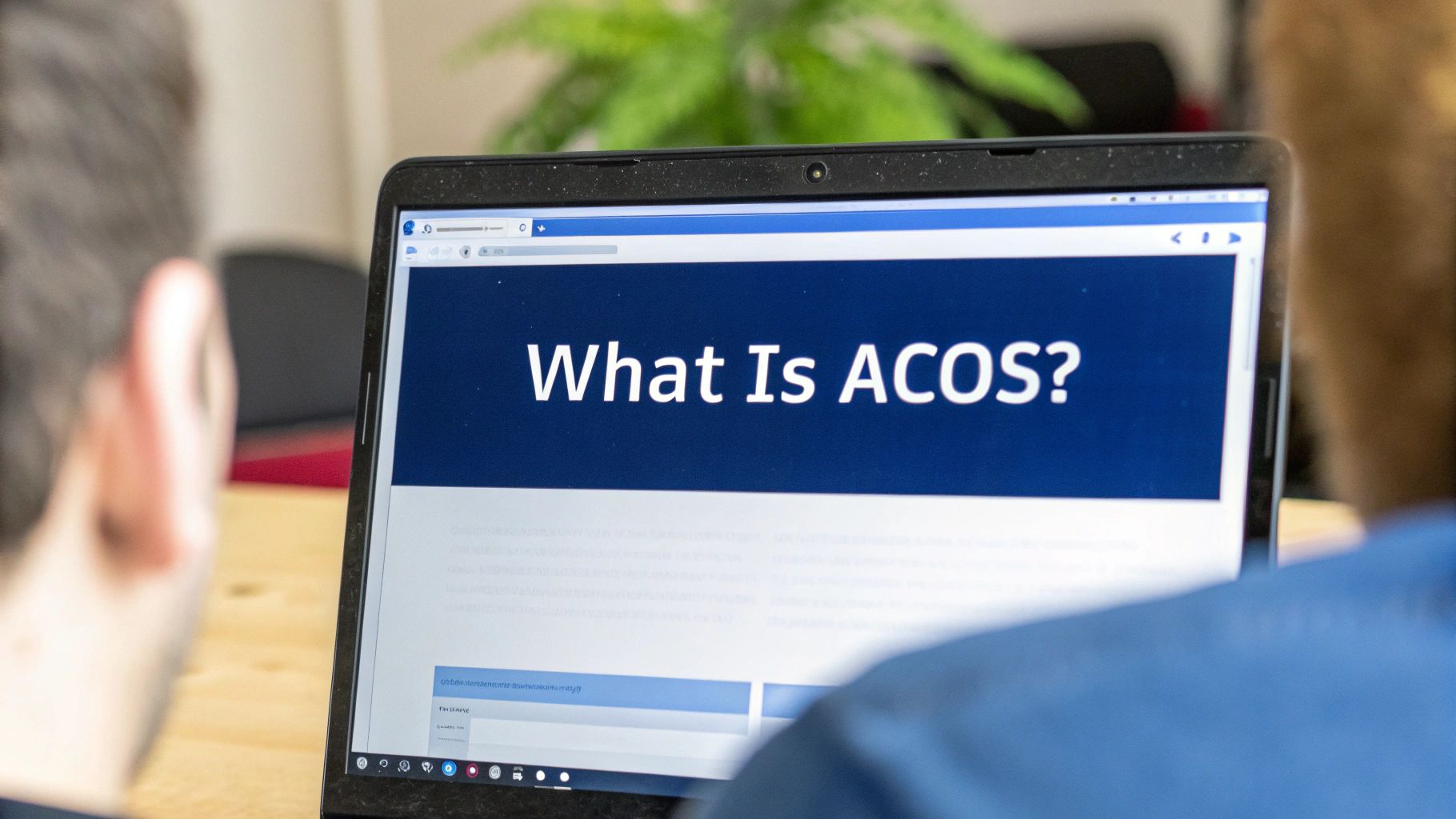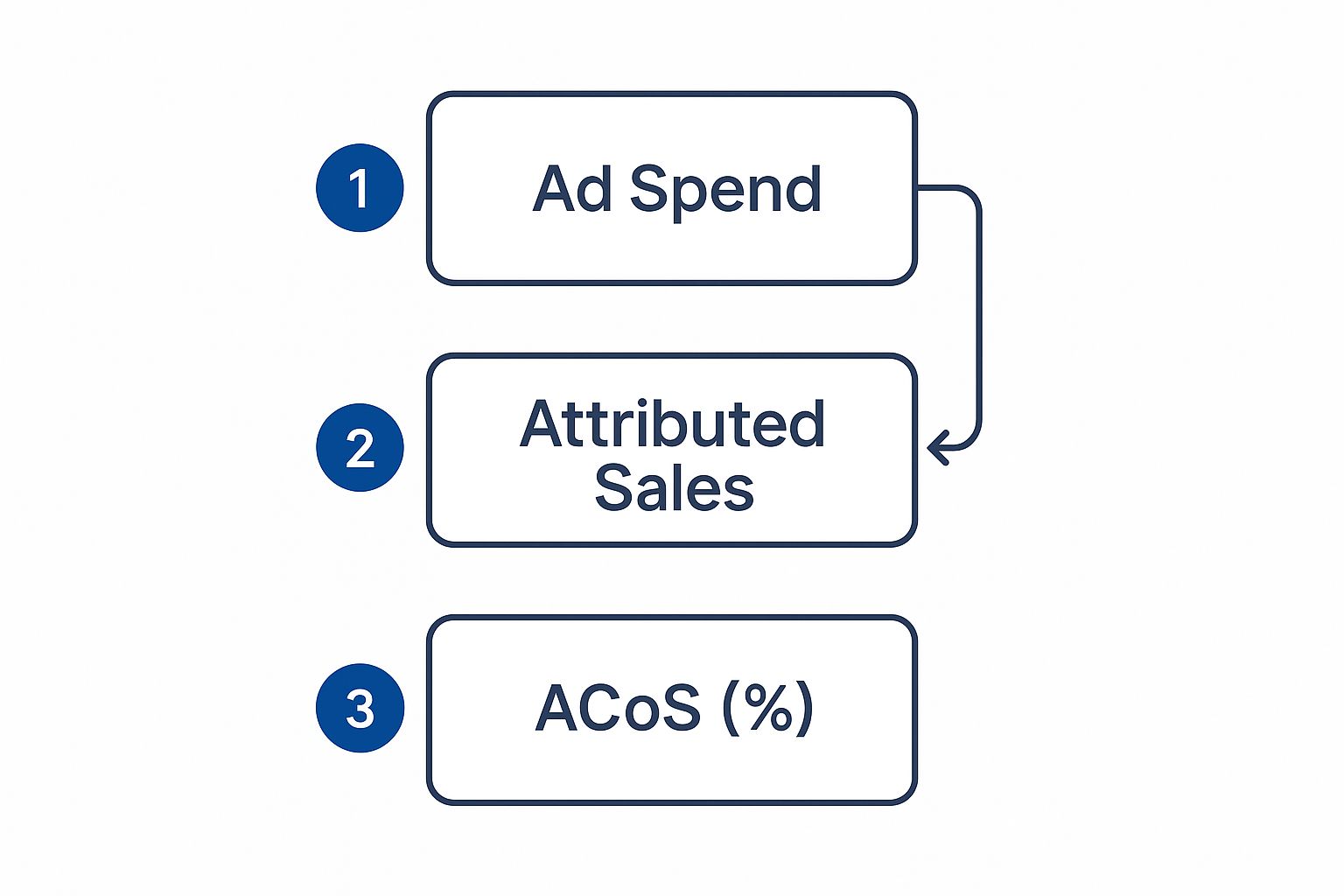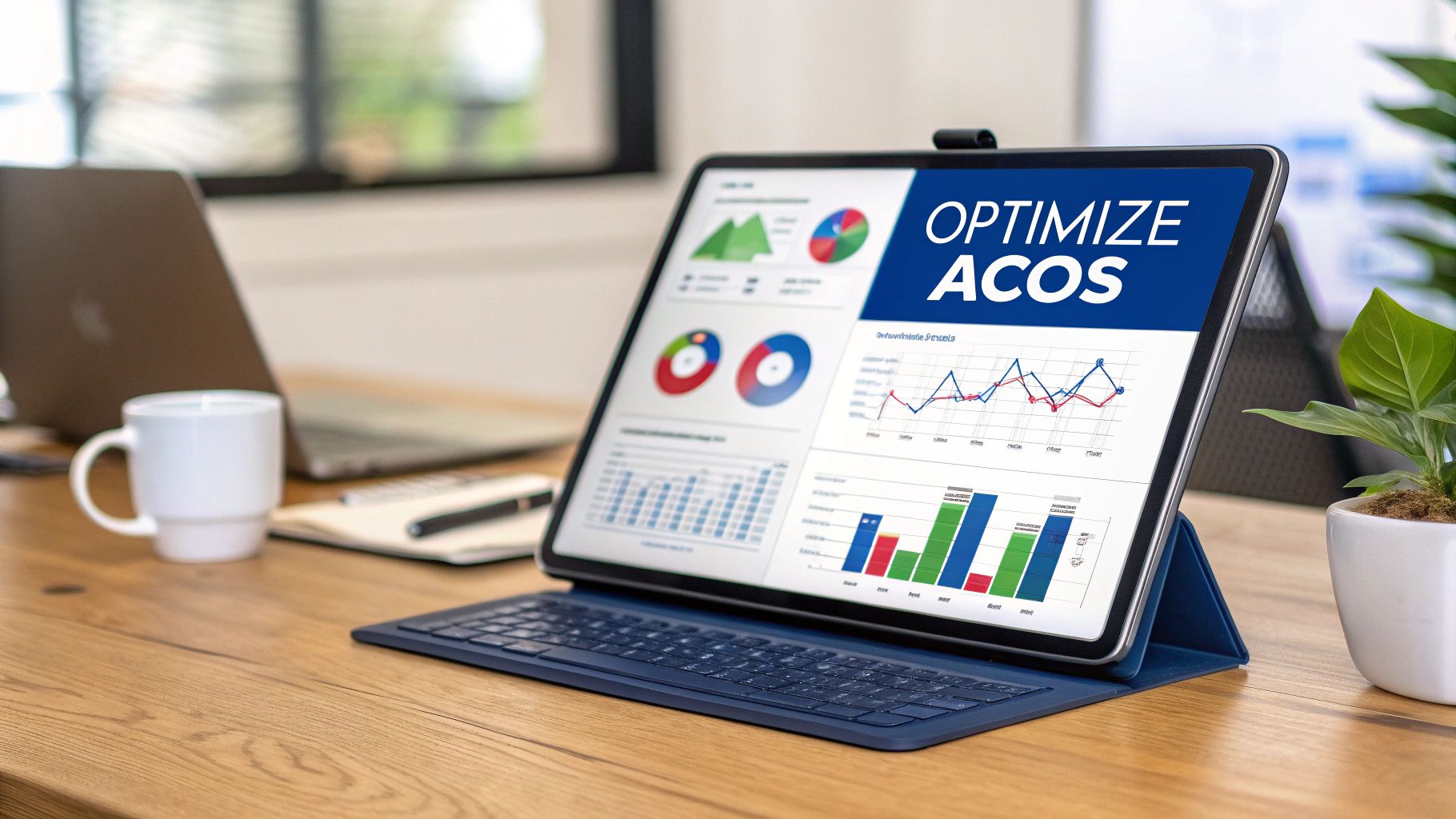Master ACoS in Amazon: The Executive's Guide to Profitability & Scale
Learn how to optimize ACoS in Amazon, calculate break-even points, and boost ROI with our expert tips. Improve your ad performance today!

ACoS, or Advertising Cost of Sales, is Amazon's core metric for advertising efficiency. It measures the direct relationship between ad spend and the sales generated by those ads.
The calculation is simple: (Total Ad Spend ÷ Total Ad Sales) × 100. A $25 ad spend that generates $100 in sales results in a 25% ACoS. But for senior leaders, the real question isn't "what is ACoS," it's "how can I use it as a lever for sustainable growth?"
Understanding ACoS Beyond the Buzzword

For years, the prevailing wisdom has been to chase the lowest possible ACoS. This is a critical strategic error. An exceptionally low ACoS often signals missed opportunities, overly conservative bidding, and stagnated market share. It's a sign of playing defense, not offense.
At Headline, we treat ACoS not as a score to be minimized, but as a strategic control dial. It's a metric to be intentionally manipulated to achieve specific business objectives, from aggressive market penetration to disciplined profit harvesting.
The strategic application of ACoS is its most powerful function. The ACoS target for launching a disruptive product should be radically different from the target for a mature, category-leading SKU. Mastering this distinction is the first step toward building a PPC strategy that drives real enterprise value.
ACoS as a Strategic Control Dial
Think of your ACoS as a rheostat controlling your brand's growth engine on Amazon.
During a new product launch, you turn the dial up. A higher ACoS is accepted—even planned for—to accelerate sales velocity, secure critical early reviews, and rapidly climb organic search rankings. This initial ad spend is a direct investment in powering Amazon's flywheel, building the foundation for long-term organic dominance and reduced customer acquisition costs.
Once market position is established, you dial it back. The strategic focus shifts from aggressive growth to maximizing contribution margin. Industry benchmarks, which often place average ACoS between 25% and 36%, are largely irrelevant without this strategic context. They are a compass, not a map.
Here’s a practical framework for aligning ACoS targets with business goals.
Strategic ACoS Scenarios at a Glance
This table breaks down how to think about ACoS based on your current objective.
| Business Objective | Typical ACoS Target | Primary Goal |
|---|---|---|
| Product Launch | 40% - 80%+ | Gain sales velocity and market share |
| Profit Maximization | 10% - 25% | Drive efficient, profitable sales |
| Brand Defense | 25% - 40% | Protect top positions from competitors |
| Liquidate Inventory | 50%+ | Clear stock quickly, even at a loss |
As illustrated, a single "good" ACoS does not exist. The right target is entirely dependent on your immediate strategic priority.
The Key Takeaway: The conversation must shift from "What is a good ACoS?" to "What is the right ACoS for our current business objective?" This change in perspective is fundamental for any brand serious about winning its category on Amazon.
When viewed through this lens, ACoS transforms from a simple performance indicator into a powerful lever for growth, profitability, and market leadership. To contextualize ACoS within a broader framework, review our guide on other key online advertising performance metrics. Next, we’ll establish the financial guardrails necessary to set and achieve these targets profitably.
Figuring Out Your Break-Even ACoS for Real Profitability
Targeting an arbitrary ACoS without understanding your product's unit economics is financial malpractice. A "good" ACoS for one brand could drive another into insolvency. Data-driven advertising decisions must be anchored to your unique cost structure, starting with your break-even ACoS.
This metric represents the absolute ceiling for your ad spend—the ACoS percentage at which you are neither making nor losing money on an ad-generated sale. Any ACoS below this threshold contributes to your bottom line; anything above it is a planned investment (or an unplanned loss). Knowing this figure is non-negotiable for scaling profitably.
Your break-even ACoS isn't a performance target—it's your financial guardrail. It converts ad spend from a speculative expense into a predictable investment, ensuring every campaign is built on a foundation of profitability.
Calculating Your True Profit Margin
Before calculating break-even ACoS, you must determine your pre-ad profit margin with precision. This requires a comprehensive accounting of every cost associated with selling your product on Amazon, far beyond the Cost of Goods Sold (COGS).
A common oversight is failing to account for all of Amazon's variable fees. To build an accurate financial model, you must deduct every fee from your product's sale price.
Here is a checklist of costs to include:
- Cost of Goods Sold (COGS): The direct manufacturing or procurement cost.
- Amazon Referral Fees: The commission Amazon charges on each sale, typically 8% to 15%.
- Fulfillment Fees (FBA): The cost for Amazon to pick, pack, and ship.
- Shipping & Inbound Costs: The expense of transporting inventory to Amazon's fulfillment centers.
- Overhead & Other Costs: Variable costs such as packaging, returns, and software subscriptions must be factored in.
Let's apply this to a real-world scenario.
A Step-by-Step Calculation Example
Consider a premium kitchen gadget retailing for $75.00 on Amazon.
List All Your Costs:
- COGS: $18.00
- Amazon Referral Fee (15%): $11.25
- FBA Fulfillment Fee: $6.50
- Inbound Shipping & Prep (per unit): $1.75
- Other Variable Costs (returns, etc.): $2.50
Add Up Your Total Costs Per Unit:
- $18.00 + $11.25 + $6.50 + $1.75 + $2.50 = $40.00
Find Your Pre-Ad Profit Per Unit:
- $75.00 (Retail Price) - $40.00 (Total Costs) = $35.00
Calculate Your Pre-Ad Profit Margin:
- ($35.00 Profit ÷ $75.00 Retail Price) x 100 = 46.7%
Your break-even ACoS is 46.7%. This is your North Star. It means you can spend up to 46.7% of your ad revenue on advertising for this product before losing money on a sale.
This flow illustrates how ad spend translates into your final ACoS.

With this calculation, you can set ACoS targets that are directly aligned with your profit goals.
While a global average ACoS of around 30% is often cited, this figure is meaningless without context. For our example, a 30% ACoS is highly profitable. However, for a product with a 20% profit margin, a 25% ACoS—which might sound efficient—is actively eroding your bottom line. While you can explore Amazon’s category benchmarks and performance insights to set expectations, your own unit economics must be the final arbiter of your strategy.
Why Generic ACoS Benchmarks Are Misleading

Relying on generic industry ACoS benchmarks is one of the fastest ways to misallocate ad spend and either sacrifice profit or forfeit growth. The notion of a universal "good" ACoS is a myth.
An ACoS target that is profitable for a $15 CPG item will be catastrophic for a $200 piece of consumer electronics. Your optimal ACoS is a dynamic figure dictated by your product’s unique financial profile—its price, profit margin, and lifecycle stage.
Sophisticated advertisers recognize this. They abandon the chase for generic averages and instead architect a bespoke strategy around the financial reality of each product in their portfolio.
The Inverse Relationship Between Price and Conversion
A product's price point is a primary determinant of its ACoS potential because it directly influences consumer buying behavior. Higher-priced items inherently involve a longer consideration phase, resulting in more research clicks before a purchase and, consequently, a lower conversion rate.
This is not anecdotal; it's data-backed. For instance, data from one study showed products under $25 converted at an average of 12.5%, while items over $100 converted at just 6.4%. Since higher-ticket items require more ad spend to secure a single conversion, their sustainable ACoS target must be fundamentally different.
This dynamic is precisely why a one-size-fits-all ACoS strategy fails. A 40% ACoS could represent a brilliant investment to launch a premium product, whereas a 20% ACoS on a low-cost item might be leaving profit on the table.
The Key Takeaway: Your product's price point dictates consumer behavior and conversion economics. An ACoS strategy that ignores this is designed to fail. Goals must be built around the conversion realities of specific price tiers.
Tailoring ACoS to Your Product’s Financials
To put this into practice, consider how strategy must adapt based on price. A low-cost, high-conversion product can sustain an efficiency-focused, low ACoS target. Conversely, a premium product demands a more flexible, investment-driven approach, balancing higher ad spend against a significantly larger gross profit per unit.
The table below illustrates the clear correlation between price, conversion rates, and optimal ACoS strategy.
How Product Price Influences ACoS Strategy
| Product Price Range | Average Conversion Rate | Implication for ACoS Strategy |
|---|---|---|
| Under $25 | 12.5% | Efficiency-Focused: High conversion allows for lower ACoS targets (15-25%) while maintaining sales volume. Focus on maximizing profitability per sale. |
| $25 – $50 | 10.2% | Balanced Approach: ACoS targets can be flexible (20-35%). This range balances healthy profitability with the budget needed for steady growth. |
| $50 – $100 | 8.7% | Growth-Oriented: A slightly higher ACoS (25-40%) is often necessary to overcome lower conversion rates and maintain visibility in competitive searches. |
| Over $100 | 6.4% | Investment-Driven: Requires a strategic, higher ACoS (30-50%+) to capture sales. The focus shifts to Return on Ad Spend (ROAS) and lifetime customer value. |
A 35% ACoS can signal aggressive, healthy growth for a $75 product but may indicate gross inefficiency for a $20 item. This is precisely why leaders must mandate a shift away from generic benchmarks toward a strategy tied to the unit economics of each product.
Using ACoS as a Lever for Organic Growth
Many brands view Amazon ad spend as a cost of goods sold—a necessary evil to drive immediate sales. This is a limited and costly perspective. A sophisticated Amazon strategy treats PPC advertising not as an expense, but as a capital investment in long-term organic growth and brand equity.
The objective is not merely to "buy" today's sales; it is to ignite Amazon's flywheel. Well-executed PPC campaigns generate the sales velocity that Amazon's A9 algorithm rewards with higher organic rankings. This is the strategic pivot from minimizing ACoS to leveraging it as a tool to build a durable, defensible brand on the platform.
The Headline POV: Your ad spend is fuel for your organic engine. By strategically over-investing in PPC during key periods, such as a product launch, you generate a powerful halo effect. This investment accelerates organic visibility, which in turn reduces your long-term reliance on paid media. It is a calculated investment in market share, not a simple cost.
Launching Products with an Investment Mindset
A product launch is the quintessential scenario for this investment-led approach. A new product enters the marketplace with zero sales history, no reviews, and no organic rank—it is invisible. To gain traction, you must manufacture momentum through an aggressive, front-loaded PPC strategy with a deliberately high ACoS.
Attempting to achieve a profit-focused ACoS of 20% during a launch is a recipe for failure. The initial launch phase often requires running ads at or above break-even, with an ACoS between 50% and 80%, for the first several weeks.
This aggressive spend achieves several critical objectives:
- Drives Initial Sales Velocity: It signals relevance to Amazon's algorithm, demonstrating consumer demand.
- Secures Early Reviews: Increased sales volume accelerates the acquisition of social proof, which is essential for building trust and improving conversion rates.
- Indexes for Keywords: It forces Amazon to associate your product with high-value search terms, establishing the foundation for future organic ranking.
This high-ACoS period is a short-term investment for a long-term competitive advantage.
The Pivot to Profitability with Total ACoS (TACoS)
Following the initial launch investment, the strategic focus shifts from pure growth to sustained profitability. At this stage, ACoS targets are dialed back to levels well below your break-even point. However, ACoS alone provides an incomplete picture of performance.
To understand the true business impact of your advertising, you must track Total ACoS (TACoS).
TACoS measures your ad spend against your total sales revenue—both paid and organic. This metric provides a holistic view of advertising efficiency and its impact on your brand's overall Amazon P&L. The formula is: (Total Ad Spend ÷ Total Sales) x 100.
A declining TACoS over time, even with a stable ACoS, is the ultimate indicator of a successful strategy. It is empirical evidence that your advertising investment is driving a disproportionate increase in organic sales. For example, if your ACoS remains at 25% while your TACoS falls from 15% to 8%, it confirms your organic sales are growing faster than your ad spend. Your advertising is successfully powering the flywheel.
By monitoring TACoS, you graduate from tactical campaign management to strategic marketing investment measurement, directly linking PPC efforts to organic growth and long-term enterprise value.
Actionable Tactics to Lower Your ACoS

Moving from strategy to execution requires a disciplined playbook. To effectively manage your ACoS in Amazon, you must implement high-impact tactics that eliminate wasted spend and improve efficiency without sacrificing sales velocity.
This is about surgical precision, not generic advice. The focus is on three pillars of performance: rigorous keyword management, intelligent campaign architecture, and conversion rate optimization (CRO).
Plug Budget Leaks with Aggressive Negative Keywords
The fastest way to inflate your ACoS is by paying for irrelevant clicks. Each click from a consumer searching for a different product is wasted budget. A proactive negative keyword strategy is the most effective defense.
This practice walls off your ad budget from unqualified traffic. If you sell premium leather dog collars, you must prevent your ads from appearing for searches like "cheap nylon cat collars." Adding "cheap," "nylon," and "cat" as negative keywords instructs Amazon to stop showing your ads for these queries, redirecting that spend toward high-intent buyers.
A disciplined weekly process is critical:
- Scour Search Term Reports: Identify terms driving clicks but zero sales. These are your primary targets for negation.
- Be Decisive: Do not hesitate to negate an underperforming term. If a keyword has accumulated significant cost without a conversion, it is a budget leak that must be plugged.
- Utilize Phrase Match: Broaden your defense by using negative phrase match. Negating the phrase "for cats" blocks dozens of irrelevant search variations with a single entry.
This is not a one-time task; it is continuous, iterative optimization. To build a robust defense, review our guide on a powerful Amazon negative keyword strategy.
Structure Campaigns by Match Type for Better Control
A common tactical error is co-mingling broad, phrase, and exact match keywords within a single campaign. This creates an unmanageable environment where budget allocation is imprecise and bid control is nearly impossible. A more sophisticated approach is to segment campaigns by match type.
This structural discipline provides granular control over bidding and budgeting.
A useful mental model: Broad match campaigns are for discovery—finding new, profitable customer search terms. They will naturally operate at a higher ACoS. Exact match campaigns are for performance—targeting proven, high-converting keywords. These must run at a much lower, more profitable ACoS.
By segregating them, you can fund your discovery efforts without allowing those higher-cost exploratory campaigns to dilute the profitability of your core performers. This precision is fundamental to managing overall ACoS effectively.
Optimize Your Product Detail Page to Boost Conversions
Ultimately, even the most refined PPC campaigns will fail if the product detail page does not convert traffic into sales. Your listing is the final, critical step in the funnel. A marginal improvement in your conversion rate can have a dramatic, positive impact on ACoS.
The ACoS formula is a simple ratio of spend to sales. By generating more sales from the same number of ad clicks (i.e., improving your conversion rate), your ACoS will necessarily decrease.
Focus optimization efforts on these high-impact areas:
- High-Quality Imagery and Video: Use lifestyle images and infographics to demonstrate value and answer questions visually.
- Benefit-Driven Copy: The title and bullet points must articulate solutions to customer problems, not just list product features.
- A+ Content: This is your opportunity to build brand equity and tell a richer product story. Well-designed A+ Content has been shown to increase conversion rates by up to 10%.
Each enhancement builds consumer confidence and reduces friction to purchase. As your strategy matures, leveraging tools like AI marketing software can provide a competitive edge in optimizing campaigns for both growth and efficiency.
When a High ACoS Can Be a Smart Move
The relentless pursuit of a low ACoS is a strategic trap. Experienced Amazon operators understand that in specific situations, a high ACoS is not a sign of failure but a calculated investment in a brand's future market position.
This isn't about inefficient spending. It is a deliberate decision to prioritize long-term strategic objectives over short-term profitability.
Strategic Scenarios for a High ACoS
When does it make sense to intentionally run ACoS above your break-even point? Several scenarios require an investment mindset where the goal is capturing market share that will yield returns far into the future.
Launching a New Product: With no sales history or organic rank, a new product requires manufactured momentum. An ACoS of 50-80% or higher is often the necessary investment to secure initial sales, gather reviews, and begin ranking organically. This front-loaded spend feeds the Amazon algorithm.
Breaking Into a Tough Market: Penetrating a highly competitive category requires aggressive bidding to gain visibility alongside established leaders. A high ACoS is the cost of entry, enabling you to reach qualified buyers and build brand awareness from a standing start.
Playing Aggressive Defense: If a competitor begins bidding aggressively on your core branded or category keywords, you may need to temporarily increase bids to protect your position, even if it pushes ACoS above break-even. The long-term cost of losing prime digital shelf space is often far greater than a short-term hit to profitability.
Key Takeaway: A high ACoS must be a time-bound, objective-driven strategy. Before increasing spend, define the goal (e.g., achieve top 3 rank for a core keyword), set a timeline, and establish success metrics beyond immediate profit, such as share of voice or review acquisition rate.
When deployed thoughtfully, a high ACoS in Amazon advertising is not a liability—it's a weapon. The brands that achieve category dominance are those that know precisely when to shift from an efficiency posture to one of aggressive investment, leveraging a calculated short-term loss to secure a long-term win.
Your Top ACoS Questions, Answered
We’ve covered the strategic framework for using ACoS as a growth lever. Now, let’s address the most common tactical questions that arise during implementation.
What's the Real Difference Between ACoS and TACoS?
This distinction is critical. ACoS (Advertising Cost of Sales) measures the efficiency of your paid media, comparing ad spend only to the sales directly attributed to those ads. It is a campaign-level diagnostic tool.
TACoS (Total Advertising Cost of Sales) provides a holistic business view. It measures your ad spend against your total revenue, including organic sales. TACoS is a brand-level health metric.
A declining TACoS alongside a stable ACoS is the ultimate proof of a successful flywheel effect. It demonstrates that your advertising investment is driving a larger, positive impact on organic sales and overall brand presence.
How Often Should I Actually Tweak My ACoS Targets?
Monitor ACoS performance on a weekly basis to identify trends, but avoid making reactive changes based on short-term volatility. Amazon's ad auction performance can fluctuate daily.
Major strategic adjustments to bids and budgets should be made on a bi-weekly or monthly cadence. This allows sufficient data to accrue for informed, data-driven decision-making.
The one exception is a new campaign launch. During the initial 7-14 days, more hands-on management is required to ensure proper calibration and keyword harvesting from the outset.
An extremely low ACoS isn't the trophy you think it is. More often than not, it's a red flag that you're under-investing. You're probably bidding too conservatively and missing out on a huge volume of sales, handing that market share right over to your more aggressive competitors.
Is a Super-Low ACoS Always a Good Thing?
Absolutely not. While it may appear efficient, a rock-bottom ACoS (e.g., sub-10%) often indicates an overly conservative strategy focused solely on branded search terms and a few "sure thing" keywords.
This approach, while profitable on a per-sale basis, severely limits reach and suffocates long-term growth. The strategic objective is not the lowest possible ACoS, but the optimal ACoS in Amazon—the equilibrium point that maximizes total profit dollars by balancing advertising efficiency with aggressive, scalable growth.
Ready to stop guessing and start using your ACoS as a strategic tool for growth? At Headline Marketing Agency, we live and breathe this stuff. We use a data-first approach to build Amazon ad strategies that deliver both profit and sustainable scale. Let's build your brand's dominance together.
Ready to Transform Your Amazon PPC Performance?
Get a comprehensive audit of your Amazon PPC campaigns and discover untapped growth opportunities.